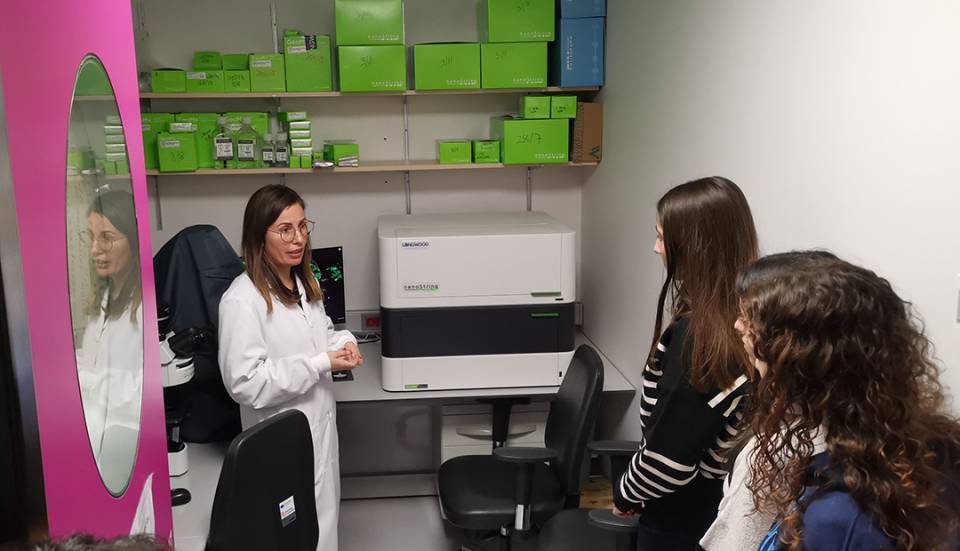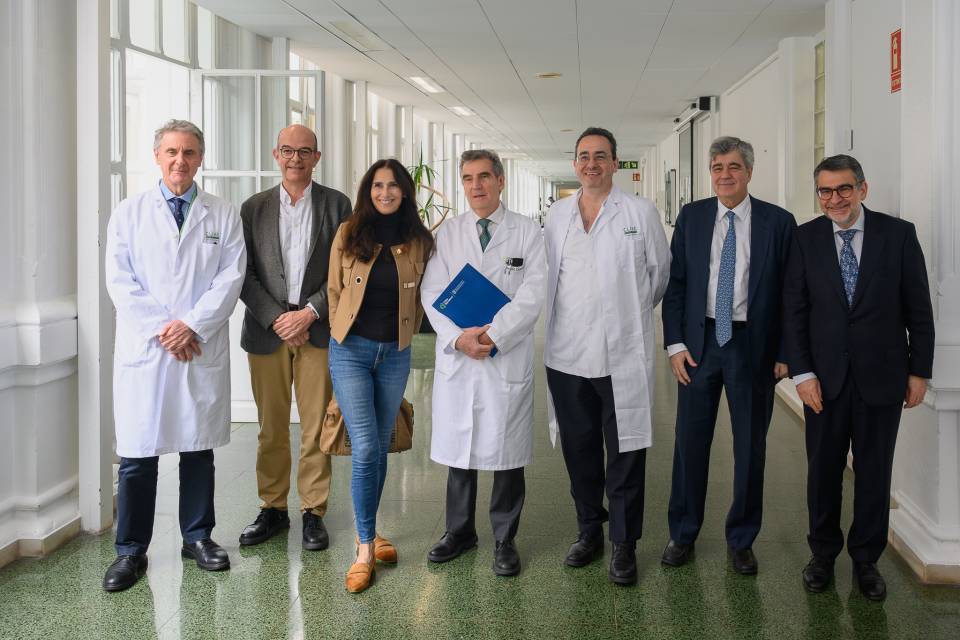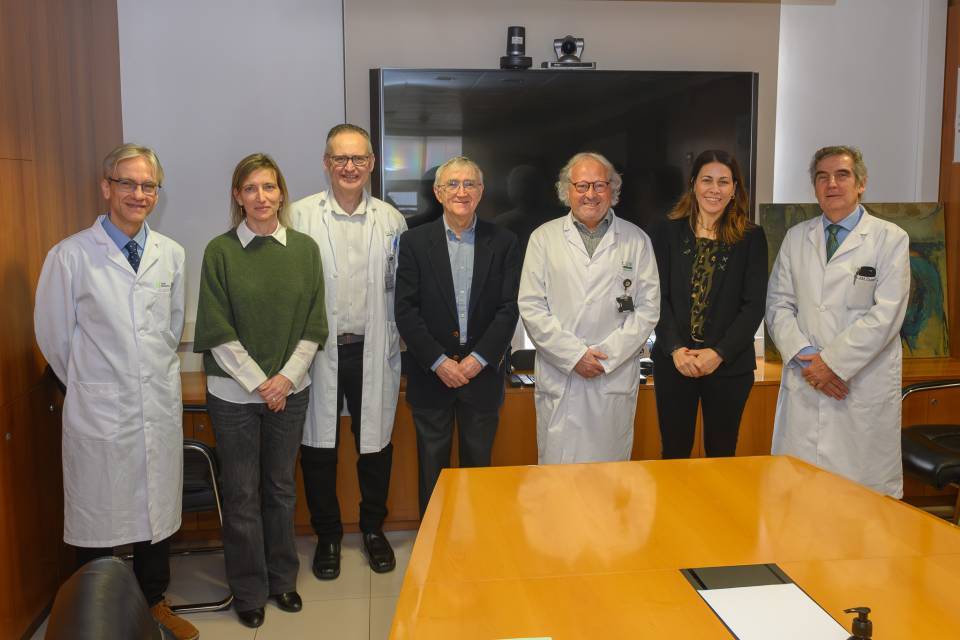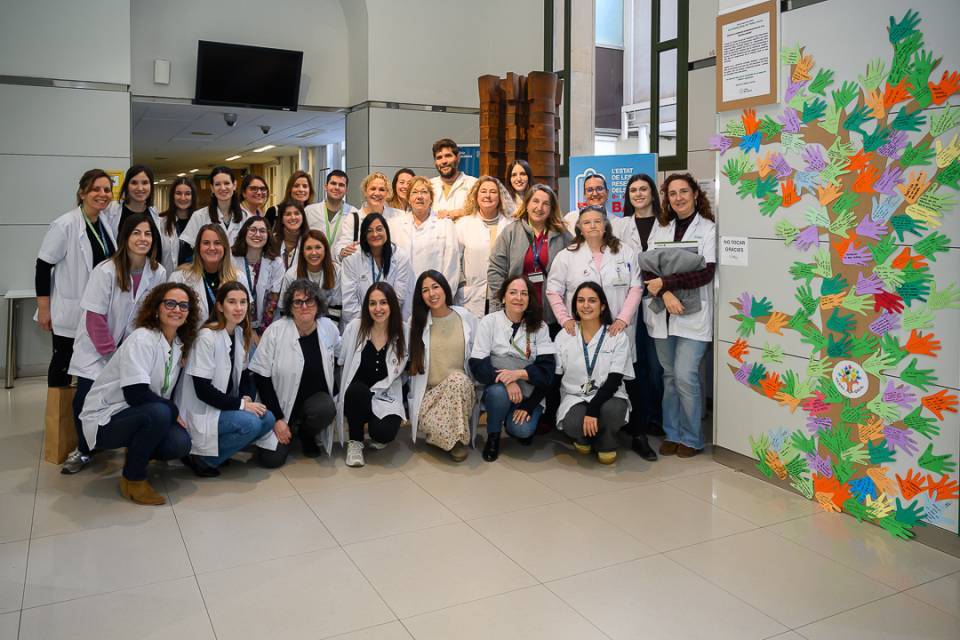Between 18 and 26 January, three IDIBAPS women researchers received secondary school students from Escola Garbí Pere Vergés in Esplugues de Llobregat and Badalona, IES Consell de Cent in Poble Sec and Escola Vedruna Gràcia in Gràcia to show them what their everyday lives are like in the laboratory and the research they carry out.
Fara Brasó-Maristany, a postdoctoral researcher in the Translational genomics and targeted therapies in solid tumours group led by Aleix Prat, works to identify new biomarkers that can predict how breast cancer patients respond to treatment. “We are also interested in being able to classify the different types of tumours according to their molecular profile, since cancer is a heterogeneous disease”, Brasó-Maristany says. On the morning of 18 January 2023, she was joined in the laboratory by Laia, Anna and Emma from the Garbí Pere Vergés School in Esplugues de Llobregat. “We were very surprised by the advanced technology they use in the laboratory. We also did not expect to see so many women in the laboratory, but this inspires us to choose a scientific career and helps us to feel sure about the decision we are making”.
The scarcity of women role models in science is one of the obstacles that young female students face when deciding their future. As Emma puts it, “these types of figures are missing”. Anna shares the same opinion and relates the experience of her mother, an engineer, who was one of only two girls in her class when she was studying for her degree. “However, science is not just for men, even if history only mentions male figures and their discoveries. Women also contribute to the advancement of science with important findings”, Laia says.
Welcoming the girls to her laboratory was a great opportunity for Brasó-Maristany to encourage them to become scientists. “I find that it is also a very enriching experience for us, the researchers”, she says. She repeated the experience the next day, on 19 January, with Ainara, Bruna and Tanja from the Garbí Pere Vergés School in Badalona. All three would like to pursue medicine or biomedicine as their first or second choice of career path. “In the end, everything will depend on our performance, but yes, we would very much like to be admitted and come to study at the Clinical Campus, where the University of Barcelona’s Faculty of Medicine, Hospital Clínic Barcelona and the IDIBAPS research centre are all located”. Medicine and research are inextricably linked, since finding a cure for a disease requires solving questions in the laboratory. “Our visit has allowed us to assess biomedical research as a way to make progress in knowledge and healthcare. We would definitely repeat the experience and recommend it to other female colleagues”.
Cancer is one of the main diseases targeted by research at IDIBAPS, but there are also many groups dedicated to liver pathologies. Sofía Pérez del Pulgar, an accredited CIBER researcher in the Viral, genetic and immune-mediated liver diseases group led by Xavier Forns, closely studies two viruses that cause hepatitis: B and Delta. Focused on observing patient samples under the microscope, she was joined by Mahruck, Zainab, Meriam and Maria, students at IES Consell de Cent, on 25 January. “Have you ever seen a liver affected by hepatitis? If you step up to the microscope, you will see how the hepatitis B and Delta viruses alter the cells. Notice those brown spots. They indicate B virus infection, while the red ones correspond to Delta. An interesting fact about Delta is that it needs proteins from B to make new viruses. If it is alone in a cell, it will only destroy it, but it will not be able to multiply”, Pérez del Pulgar explains, capturing all the girls’ attention. Next, each of them sits in the researcher’s place and explores the different stains in the patients’ tissues under the light of the microscope.

"What did you study to get here?” “Chemistry”. The girls cannot hide the surprise on their faces. “Imagine that there are very diverse profiles in a laboratory: biology, medicine, chemistry, physics, mathematics. The joint work of people with this knowledge lets us go much further in approaching and solving problems so we can move knowledge forward”, the researcher says. “And if you look around, there are also many women working in the laboratory”. One such woman, Thais Leonel, teaches the students how the PCR technique works. They end their visit by viewing DNA fragments that they separated themselves using electrophoresis. “When we arrived, we expected to see more men in the laboratory, as well as a much more serious and distant atmosphere. We really enjoyed accompanying Sofía and Thais. We don’t usually get the chance to interact directly with researchers and it has motivated us a lot to continue studying to enter medicine and biology. Maybe in a few years, we’ll also be in a laboratory”.
Ana Martínez, a predoctoral researcher in the Liver vascular biology group led by Jordi Gràcia-Sancho, welcomed the last group of students. After finishing a maths exam, Nora, Susi and Aroa, students at Escola Vedruna Gràcia, spent the afternoon of 26 January following the young researcher’s routine first-hand. Martínez works with animal and cellular models to study the mechanisms that trigger cell degradation in liver diseases. “Working with cells seems very interesting to me. Animal models, however, seem more complicated. I don’t know if I would be able to do that”, says Nora. “In fact, I see myself more as a doctor, dealing with patients every day, than as a researcher, since medicine is what I deal with every day at home”. Susi says: “I am particularly concerned about which career path I should choose and how this will affect my future. I really like research, but I’m not sure that I want to pursue a career focused exclusively on academia. I would also like to know about other outcomes, such as industry or scientific communication. Would I need to do a PhD?”

Martínez explains to the students in detail how she came to be a predoctoral researcher. The opportunities are there, including scholarships and grants. She tells them how research groups work and describes the different stages of a researcher’s career. She speaks about the frustration, but also the joy that research provides. “It’s an exciting, difficult and hard world at times, but when things go well, the joy is priceless. Studying for it and doing a PhD are exciting years”. Aroa says: “We came here very motivated, because we are very interested in the world of science, but we also know that not everything is perfect and beautiful. The truth is that we really appreciate the opportunity to get this honest and realistic view, from a person who is dedicated to research. We loved the activity. If you do something similar again, please let us know”.
This activity, organised by the IDIBAPS UCC+I, is supported by FECYT.




